- Home
- Things to Do in Sicily
- Godfather Locations
Michael Corleone in Sicily: Exploring the Iconic Godfather Filming Locations
Sicily's sun-baked hills and ancient towns became forever linked to American cinema when Francis Ford Coppola chose them as the backdrop for The Godfather trilogy. These locations didn't just serve as sets—they became characters in the Corleone family saga.
The Godfather movies are cinematic masterpieces. They tell the story of the Corleone family. The saga begins with the wedding. Vito Corleone (Marlon Brando) is the family's patriarch, and his daughter is getting married.
Vito's son, Michael (Al Pacino), and his American girlfriend, Kay (Diane Keaton), are among the guests. Michael has distanced himself from the family. He is an outsider among the guests.
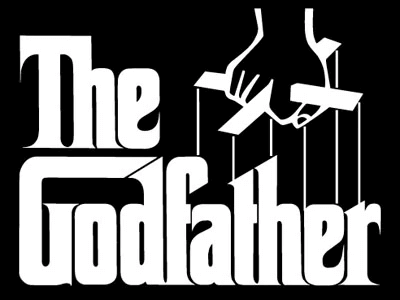
The Godfather movies follow Michael Corleone as he gradually returns to his roots, to the family "business." Michael aims to clean up the business from illegal elements, but breaking away from tradition turns out to be next to impossible.
So, why did Michael Corleone go to Sicily? The background to this is his father's wounding in an ambush. As much as Michael resists his family's legacy, he cannot refrain from avenging the attack on his father.
After avenging his father's killers, it is Michael's turn to flee from revenge. He is sent to Sicily, the birthplace of his family. There, he begins to bond with the old family traditions.
The second part of the saga, The Godfather II, tells the story of Michael's father, Vito Corleone (Robert de Niro), journey to America.
The third part becomes a bloody spectacle as the trilogy approaches its tragic end.
Some of the most impressive scenes in the Godfather trilogy are set in Sicily, the birthplace of the Corleone family. Here, on this page about Michael Corleone in Sicily, we delve into these iconic filming locations.
Most of these places are around Taormina and easily accessible by car. The other is in Palermo. From there, if you are interested in actual mafia history, it is an easy ride to the town of Corleone - a real-life hotbed for mafia action but not shown in the movies.
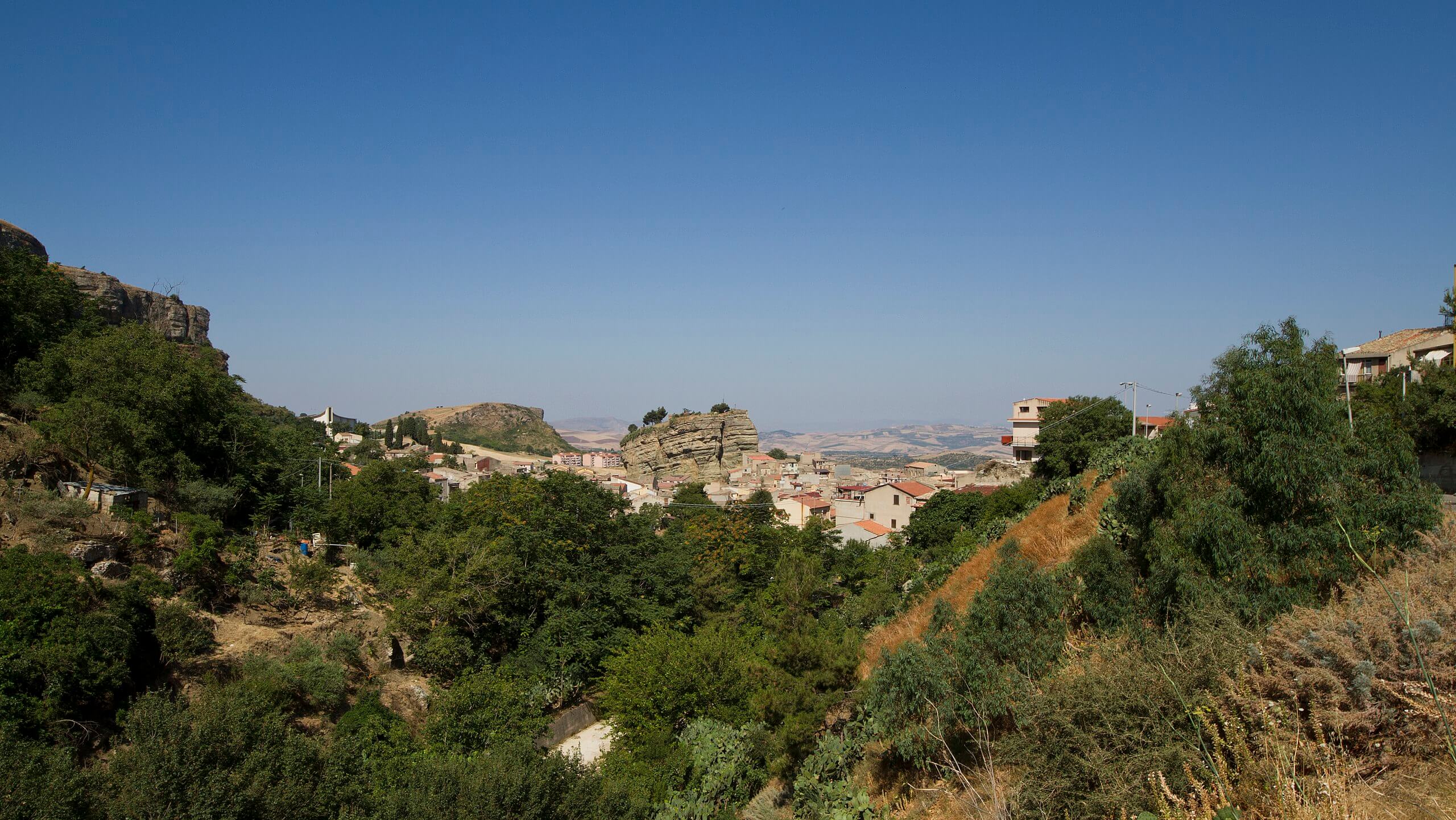 Hills surround Corleone. They have provided perfect hiding places for the bandits throughout the ages. The town didn't show in the movies, but is a must-visit for anyone interested in the real-life mafia history. (Photo: trolvag / Wikimedia Commons)
Hills surround Corleone. They have provided perfect hiding places for the bandits throughout the ages. The town didn't show in the movies, but is a must-visit for anyone interested in the real-life mafia history. (Photo: trolvag / Wikimedia Commons)The Dramatic Landscapes of Sicily: A Perfect Backdrop for the Godfather Movies
Sicily, the sun-drenched island off the southern coast of Italy, has long been a captivating destination for filmmakers. Classics such as Cinema Paradiso (1988), The Leopard (1963), and Il Postino (1994) were filmed on the island.
Sicily's rugged landscapes have inspired poets and storytellers since ancient times. They offer the perfect conditions for an epic saga of violence and family relations, like the Godfather trilogy.
So, let's step out of the silver screen and immerse ourselves in the locations where these memorable scenes were captured - now inextricably linked to the Corleone family's story.
The moment we see Michael Corleone in Sicily, every Godfather fan recognizes the transformation beginning. You can walk those same paths today—here's how.
Sant'Alessio: The "Corleone" of Godfather Movies
In the first part of the Godfather trilogy, we see Al Pacino's Michael Corleone in Sicily. He walks in the hills with his two bodyguards. They see a town in the distance. One man points to it and says, "Corleone." In reality, the place is Sant'Alessio.
Why not use the real Corleone? The real Corleone had become too modern for director Francis Ford Coppola. There were also safety concerns. In the end, it was easier to find spots in the picturesque coastal towns in the Taormina region.
Sant'Alessio was also used in the other parts of the trilogy to represent the birthplace of the family patriarch, Vito Corleone.
The funeral march scene at the beginning of the second part is also filmed in front of Sant'Alessio.
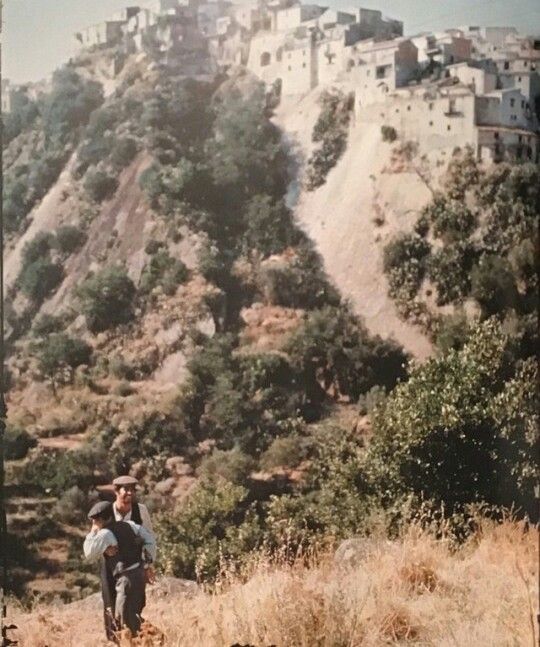 Michael Corleone in Sicily. Sant'Alessio plays the role of Corleone in the background.
Michael Corleone in Sicily. Sant'Alessio plays the role of Corleone in the background.Savoca: The Wedding Town
Twenty minutes north of Taormina lies the picturesque town of Savoca, where one of the film's iconic scenes was captured.
The backdrop of Savoca's historic center and its views of the Ionian Sea served as the setting for Michael Corleone and Apollonia Vitelli's lavish wedding.
The event symbolized a turning point in Michael's thinking. Previously, he saw himself primarily as an American. Now, he is beginning to turn to his father's traditions and finding his Sicilian identity—for better or worse.
Savoca is a small town just north of Taormina. This makes it an ideal day trip destination for those holidaying on the region's famous beaches.
The wedding scene was filmed at the Chiesa di San Nicolo. It's a steep climb uphill, but well worth the effort.
Savoca is a very traditional Sicilian town, so it was chosen for the film. Like other small Sicilian towns, it has good food and drink and a traditional atmosphere.
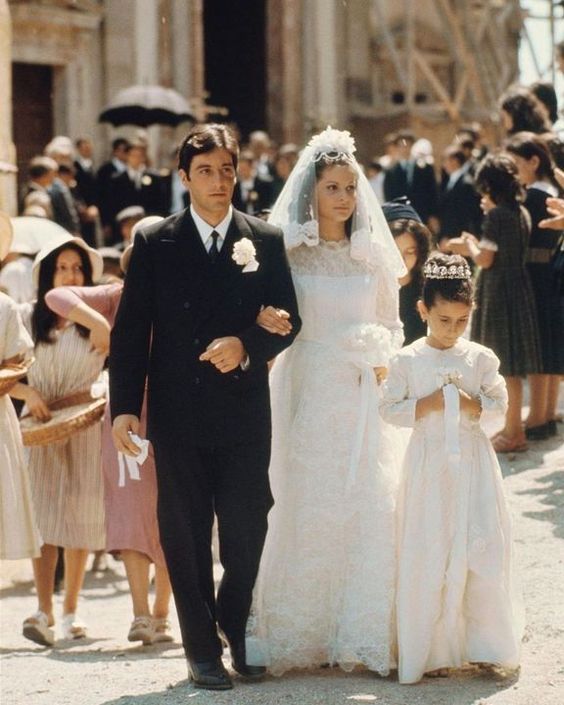 After leaving America behind, Michael Corleone finds new love in his family's native Sicily.
After leaving America behind, Michael Corleone finds new love in his family's native Sicily.Bar Vitelli: Michael Falls in Love
Bar Vitelli is also in Savoca. It serves as the setting for a scene in which Michael first meets Apollonia and begins his journey deeper into Sicilian culture. It is a moment of innocence and beauty, before a descent into darkness and corruption.
Bar Vitelli is open from morning to evening (approx. 9 am to 8 pm). Opening hours may vary, so it is best to check with the establishment.
While visiting Bar Vitelli, travelers can also stroll through Savoca's historic center and soak in the serene atmosphere that has remained essentially unchanged since the film's production.
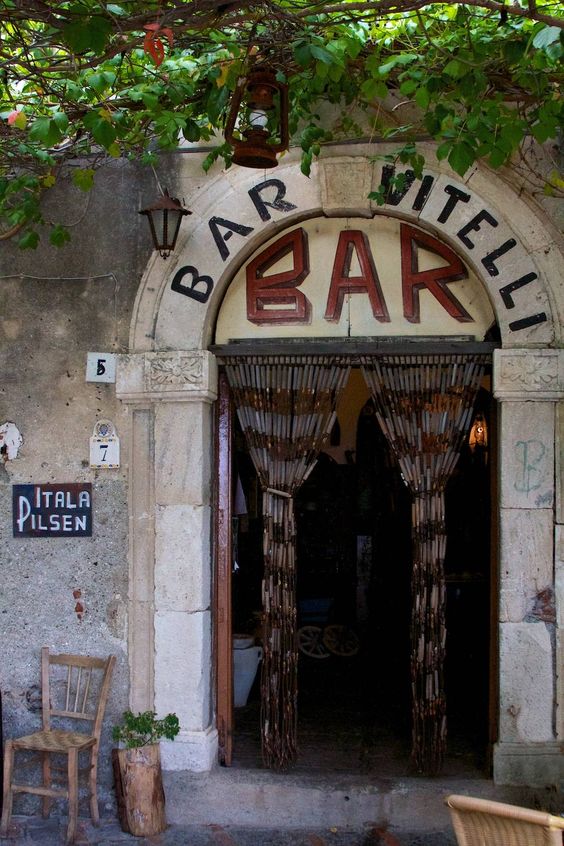
Forza d'Agrò: Where It All Begins - Including the End
While Savoca's church hosted the wedding, nearby Forza d'Agrò served as a backdrop in many other key scenes.
The church of Forza d'Argo appears in many of the Godfather movies. In Godfather II, young Vito departs from his shelter in a donkey-drawn carriage on his journey to America.
The church appears again later in the movie when the grown-up Vito Corleone returns to Sicily to avenge his father's murder. Before returning to America, he visits the church.
In Godfather III, we again find Michael Corleone in Sicily, this time with his wife, Kay (Diane Keaton). On their way, they see a wedding party in this same church.
Afterward, they drift to the Forza d'Agro's main piazza to celebrate and watch a puppet show with the wedding party.
Forza d'Agro is a small hilltop town near Taormina. You get there by driving up a winding road from the coast of the Ionian Sea. Much of the city is made up of cobbled alleys inaccessible by car.
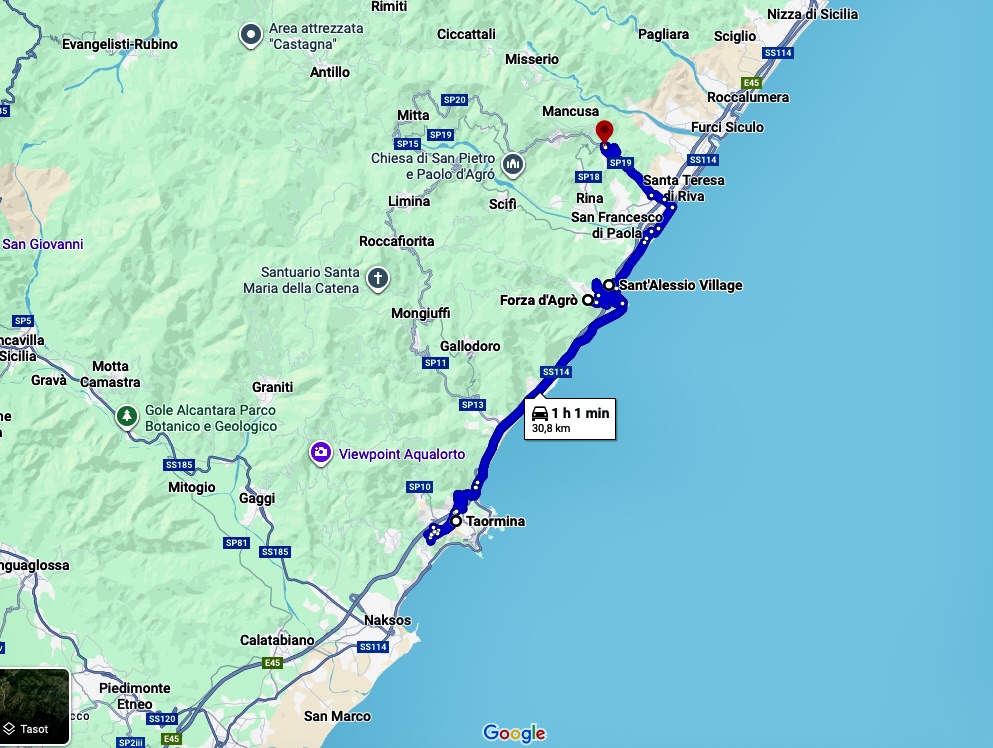 Most of the Sicilian scenes in the Godfather films are a short drive from Taormina. The red spot is Savoca.
Most of the Sicilian scenes in the Godfather films are a short drive from Taormina. The red spot is Savoca.The church in question is called the Church of Santa Maria Assunta. It can be easily found by following the "Duomo" signs. There are three other churches in the town. Of them, the Church of Holy Trinity is particularly worth a visit.
At the top of the hill are the ruins of the Norman castle. On the way to the castle, you can stop at a small piazza, where you will find the bicycle used in Godfather III. The priest drove the bike in the film and threw the wedding bouquet to Michael's wife, Kay.
While at the main piazza, you can also enjoy the refreshments in a Godfather-themed restaurant, Il Padrino.
Palermo: The Tragic Ending
Palermo is the lively capital of Sicily. For sightseeing, there's little on the island to rival it.
In The Godfather III, Palermo's opera house, Teatro Massimo, is the backdrop for the bloodshed that ends the saga.
The theatre's surroundings are an excellent place to hang out. After photographing yourself in front of the recognizable façade of this legendary building, you can take a guided tour to see the place from the inside.
The other option to get inside is booking a concert ticket. Teatro Massimo is one of Europe's oldest and largest opera houses, and seeing a performance there is sure to be a memorable experience.
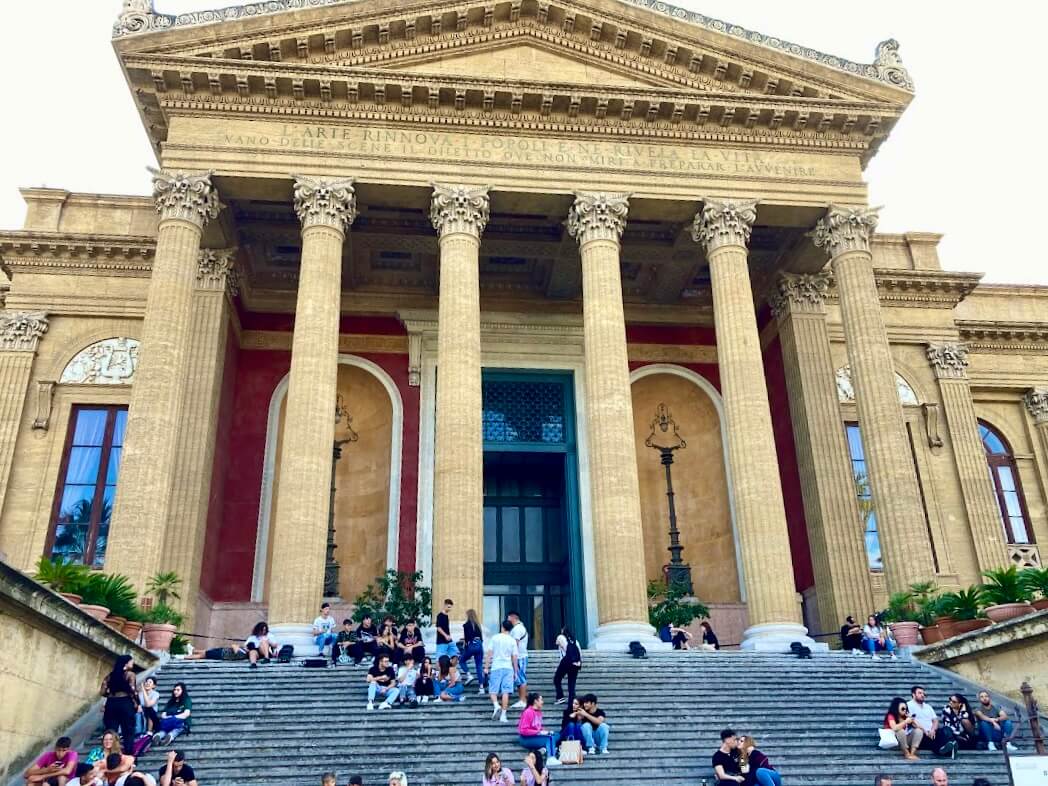 Teatro Massimo in Palermo.
Teatro Massimo in Palermo.Conclusion: Michael Corleone in Sicily - The Godfather Locations
The Godfather's legacy as one of the greatest cinematic masterpieces ever is undeniable.
The film's iconic scenes and characters have become inextricably linked to Sicily. From the charming streets of Savoca to the Palermo opera house, each destination offers a unique opportunity to step into the world of the Corleone family.
The real Corleone hasn't much to do with the films, although it has played its part in the island's history of organized crime.
While visiting Sicily, it is worth noting that while The Godfather romanticizes Mafia culture, Sicily has worked hard to overcome this legacy.
Many Sicilians might have mixed feelings about Godfather tourism. While it brings economic benefits, some worry it perpetuates stereotypes.
Today's Sicily celebrates its resistance to organized crime through museums, memorials to anti-Mafia judges, and cultural initiatives. Respect local sensitivities by learning about Sicily beyond the films.
(Last edited: August 12, 2025)
Recent Articles
-
Honeymoon in Sicily: Where Landscapes Stir the Heart
Dec 17, 25 12:21 PM
Honeymoon in Sicily: Timeless temples, coastal hideaways, slow meals, and landscapes that invite closeness. -
Best Time to Visit Sicily: Your Seasonal Guide
Dec 05, 25 04:23 AM
Find the best time to visit Sicily. Explore seasonal weather, crowds, prices, and highlights. -
Where to Stay in Sicily: Top Areas for Every Traveler
Nov 27, 25 08:14 AM
Where to stay in Sicily: A guide to the island’s best regions, helping you choose the perfect base for your trip.
Follow MANY FACES OF SICILY on Facebook, Instagram, Bluesky & Tumblr
Contact: vesa@manyfacesofsicily.com







